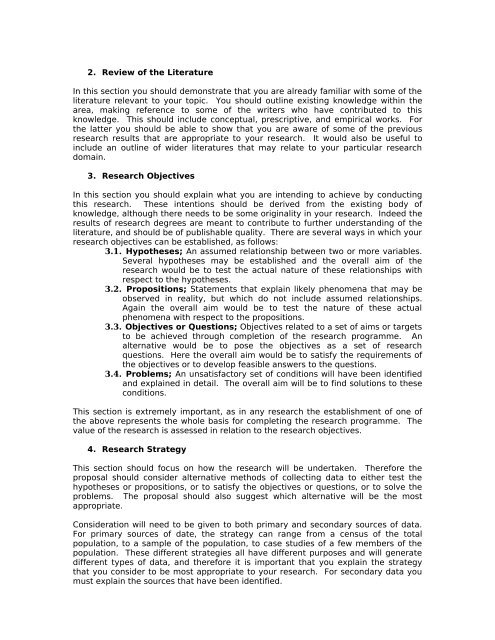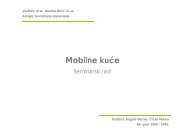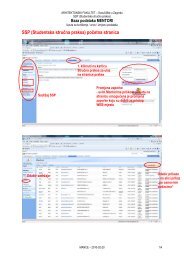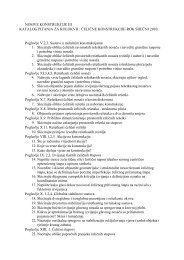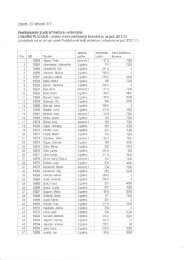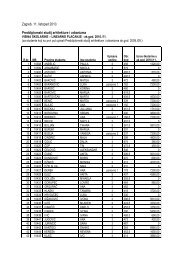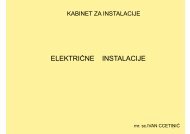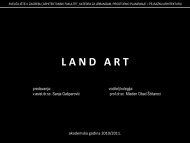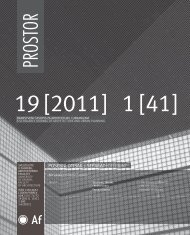Upute za doradu prijava na DS Arhitektura i urbanizam 08.03.2013 ...
Upute za doradu prijava na DS Arhitektura i urbanizam 08.03.2013 ...
Upute za doradu prijava na DS Arhitektura i urbanizam 08.03.2013 ...
Create successful ePaper yourself
Turn your PDF publications into a flip-book with our unique Google optimized e-Paper software.
2. Review of the Literature<br />
In this section you should demonstrate that you are already familiar with some of the<br />
literature relevant to your topic. You should outline existing knowledge within the<br />
area, making reference to some of the writers who have contributed to this<br />
knowledge. This should include conceptual, prescriptive, and empirical works. For<br />
the latter you should be able to show that you are aware of some of the previous<br />
research results that are appropriate to your research. It would also be useful to<br />
include an outline of wider literatures that may relate to your particular research<br />
domain.<br />
3. Research Objectives<br />
In this section you should explain what you are intending to achieve by conducting<br />
this research. These intentions should be derived from the existing body of<br />
knowledge, although there needs to be some origi<strong>na</strong>lity in your research. Indeed the<br />
results of research degrees are meant to contribute to further understanding of the<br />
literature, and should be of publishable quality. There are several ways in which your<br />
research objectives can be established, as follows:<br />
3.1. Hypotheses; An assumed relationship between two or more variables.<br />
Several hypotheses may be established and the overall aim of the<br />
research would be to test the actual <strong>na</strong>ture of these relationships with<br />
respect to the hypotheses.<br />
3.2. Propositions; Statements that explain likely phenome<strong>na</strong> that may be<br />
observed in reality, but which do not include assumed relationships.<br />
Again the overall aim would be to test the <strong>na</strong>ture of these actual<br />
phenome<strong>na</strong> with respect to the propositions.<br />
3.3. Objectives or Questions; Objectives related to a set of aims or targets<br />
to be achieved through completion of the research programme. An<br />
alter<strong>na</strong>tive would be to pose the objectives as a set of research<br />
questions. Here the overall aim would be to satisfy the requirements of<br />
the objectives or to develop feasible answers to the questions.<br />
3.4. Problems; An unsatisfactory set of conditions will have been identified<br />
and explained in detail. The overall aim will be to find solutions to these<br />
conditions.<br />
This section is extremely important, as in any research the establishment of one of<br />
the above represents the whole basis for completing the research programme. The<br />
value of the research is assessed in relation to the research objectives.<br />
4. Research Strategy<br />
This section should focus on how the research will be undertaken. Therefore the<br />
proposal should consider alter<strong>na</strong>tive methods of collecting data to either test the<br />
hypotheses or propositions, or to satisfy the objectives or questions, or to solve the<br />
problems. The proposal should also suggest which alter<strong>na</strong>tive will be the most<br />
appropriate.<br />
Consideration will need to be given to both primary and secondary sources of data.<br />
For primary sources of date, the strategy can range from a census of the total<br />
population, to a sample of the population, to case studies of a few members of the<br />
population. These different strategies all have different purposes and will generate<br />
different types of data, and therefore it is important that you explain the strategy<br />
that you consider to be most appropriate to your research. For secondary data you<br />
must explain the sources that have been identified.


